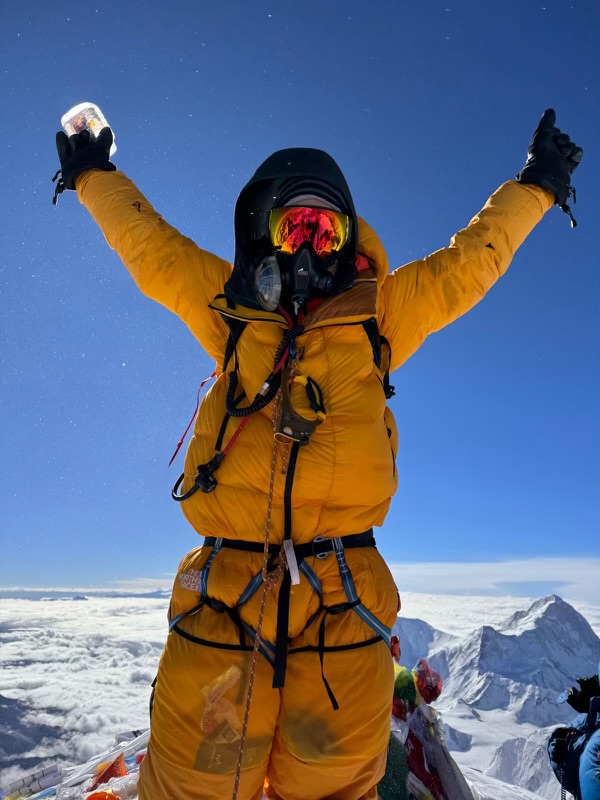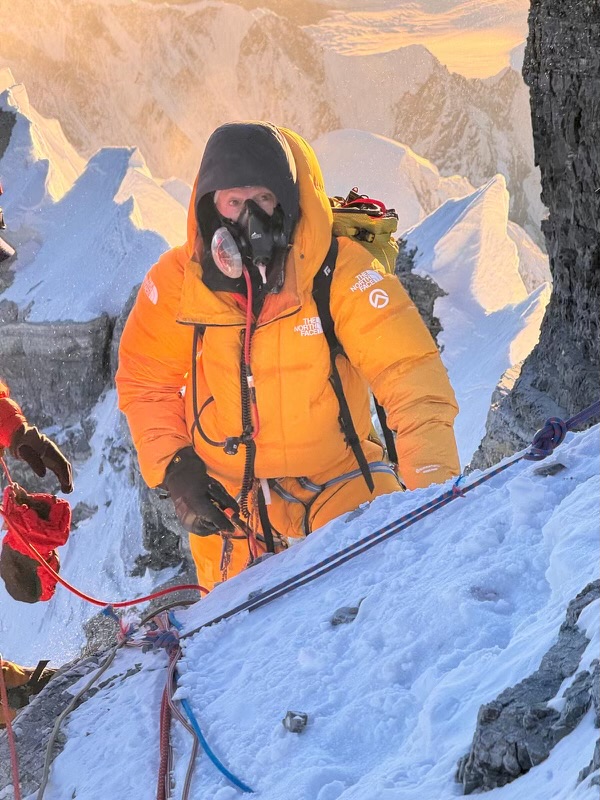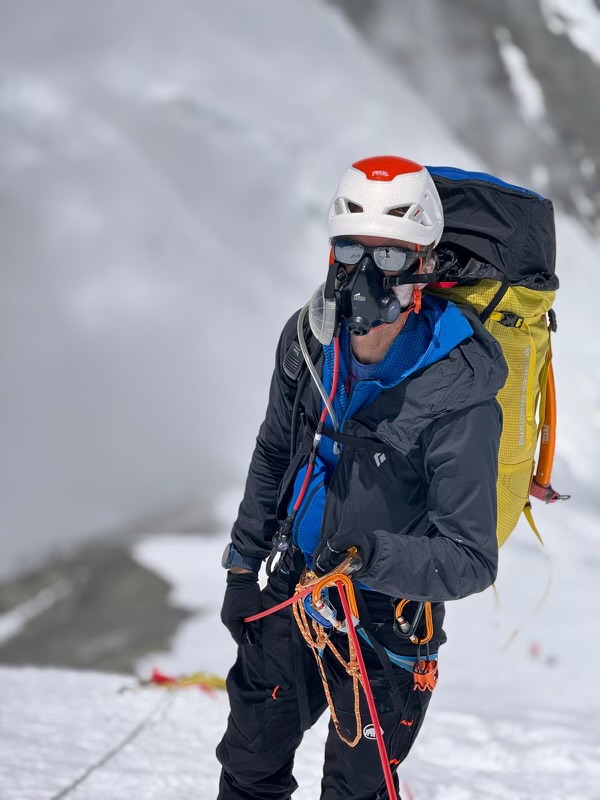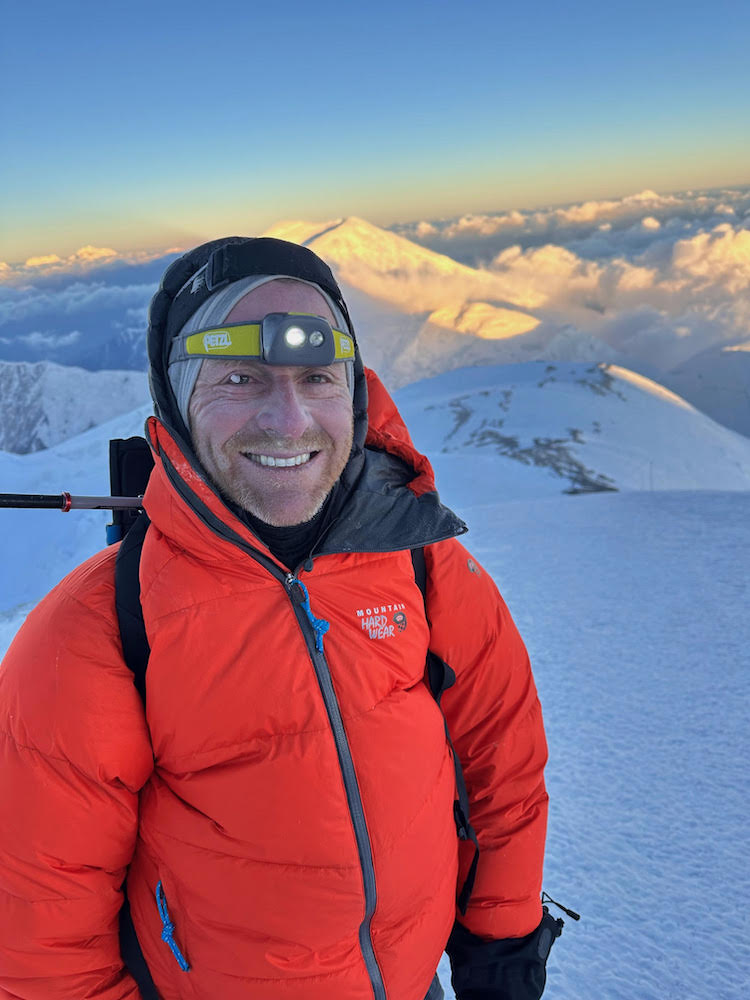
Piedmont Exedra contributor Ulla Smit interviewed Graham Cooper earlier this month as part of our occasional Piedmont Profile series. A longtime mountaineer, Cooper summited Mount Everest on May 29 with an expedition team of 23 climbers (six clients, five guides and 12 sherpas). The Los Angeles Times ran an in-depth article about the climber’s novel pre-summit training on April 29. Cooper has also competed in the Ironman World Championship 11 times and has won the 100-mile Western States Endurance Run.
Piedmont Exedra: First of all, congratulations from everyone here at Piedmont Exedra on your monumental achievement. You are a longtime climber and have slept under a hypoxic tent and eaten like a monk before. How else did you physically prepare for the climb?
Cooper: I lived in Tahoe and spent most of my time hiking up the hills either on backcountry skis or in my mountain boots with a weighted pack. For the past six months, I spent 25-30 hours a week training intensively.
Piedmont Exedra: Climbing requires a focused, yet flexible mindset. You want to reach the top, yet be able to turn around if needed and live to climb another day. How would you describe your mindset?
Cooper: My mindset was that we were going to the top. I couldn’t really think about anything else. In my view, as a climber with a guide, it’s the guide’s job to turn us around if things get too sketchy. But as the climber, I don’t even want those thoughts creeping in.
Piedmont Exedra: Climbing seems like a solo sport, while also collaborative. How important was the team for you?
Cooper: Our core climbing group for the summit push was Adrian [Ballinger], plus two sherpas. There were other members of the broader expedition, and we would of course look out for each other if there was an emergency — and there was — but the four of us were climbing together at our own pace.

Piedmont Exedra: You had permitting issues in China, delaying your trip and shortening essential high altitude acclimatization time at base camp. How were you able to continue?
Cooper: If we hadn’t been using the hypoxic tents at home and had that opportunity to pre-acclimatize, the trip wouldn’t have been possible. It turned out to be a key element.
Piedmont Exedra: The ascent from the North Face is notoriously difficult, and at this point, you’re in the most dangerous part of Everest — the “Death Zone.” At 26,000 feet and above, survival depends on getting down. Can you describe the final day for us?
Cooper: We went to bed in Camp 3 (27,400 feet) at 6 p.m., with a plan to get up at 11 p.m. and start climbing at 1 a.m. As we went to bed, the wind had whipped up to a level that would not be possible for climbing — probably 40 knots. The tent was being buffeted, and it seemed very likely that our climb would be over. You can’t “wait it out” at Camp 3. It’s too high, so you either have to go up or down fairly soon. But around 9 p.m., the wind died down, and the climb was on.
The climb on Summit day is about 1,600 vertical feet itself, which doesn’t sound like that much but each step is difficult and slow. There are three “steps” — vertical or near-vertical sections with ropes and ladders that require a lot of focus. It took us about six hours to get to the summit.
On summit day you start in the dark, and you cannot see the summit for several hours. Even after it starts to get light, your view is obscured. There are two false summits: steep slopes that feel like they should be the summit, but once you get to the top you realize you still have 30 or 45 minutes to climb. So that’s disheartening. Finally, within 10 minutes of the true summit you can see it, and that’s when you know it’s in the bag. But it took us almost six hours to get to that point. There’s a lot that can go wrong in the meantime that could mess up your day.

We spent maybe 30 minutes on the summit taking pictures and enjoying the view, and then the descent came into focus. It’s critical to get as low as possible after a summit, and so we were working hard to move quickly to get down (quickly being a relative term). We made it down to Camp 1, at 23,000 feet, and spent the night there before descending the next morning to advanced base camp. It was a 15 hour day.
One issue, which I did not identify until later in the evening, is that I had gone into renal failure on the descent. My urine was dark brown when we got to Camp 1, and over the course of the next 24 hours I consumed 5 liters of water without peeing. Adrian was in the process of organizing an evacuation late the next day when my kidneys starting working again. We were obviously relieved that we didn’t need to execute a rescue, but I think that was really hard on my body.
Piedmont Exedra: What was the most difficult aspect of the climb?
Cooper: It’s hard to convey the intense mental strain of being ready for the final summit effort from Camp 3 and realizing that we would probably turn back. It looked unlikely that the wind would die down, and we needed it to drop by least half to continue. Years of training, preparing, and waiting for China to reopen its side of the mountain [after the pandemic] … the clock is ticking. The oxygen is so low at that elevation so time wasn’t on our side. We were lucky to be able to finish our climb and summit, but it nearly didn’t happen.

Piedmont Exedra: On the mountain, did your team have any setbacks or close calls?
Cooper: There was one climber who ran out of oxygen high on the descent above Camp 3. His guide gave him his cannister, but then was without oxygen himself. He had to descend several thousand feet without oxygen, and with a lot of uncertainty about where he could find some. So that was stressful and, certainly, dangerous.
Piedmont Exedra: You summited exactly 71 years to the day after Hillary and Norgay. The British viewed it as conquering the mountain, while Norgay viewed it as a spiritual pilgrimage. What is your view?
Cooper: I definitely don’t think of it as conquering; I believe in respecting the mountain and approaching the climb with humility. Hubris will knock you down and I’d rather honor the power of the mountain. Before the summit push, the sherpas hold a puja ceremony with all of us. It’s a powerful tradition with cultural significance — you’re showing respect to the mountain and asking for guidance and permission to climb.
Piedmont Exedra: What was your experience like with the sherpas on your team?
Cooper: They are really amazing. Alpenglow (the expedition company) hires all its sherpas from a small village in the Khumbu valley called Phortse, so they all know each other. So it’s like climbing with a family that all looks out for each other. And it is like a family; our group ranged in age from 20 to 50.
Piedmont Exedra: In an interview, Sir Edmund Hillary said when he and Tenzing Norgay summited, he looked over at Makalu [the fifth highest mountain on earth, also in the Himalayan range] and started planning that ascent. Did you stay in the moment of celebration, or did you take a look around?
Cooper: We definitely took a look around. We ended up being the very last group allowed on the mountain for the 2024 season (due to the permit delay), and as a result we had the summit to ourselves. I didn’t even know where the southern route came up — Adrian had to point it out to me. And I could look down that path, as far as the eye could see, and not see a single person. So in contrast to every story you’ve heard about Everest being crowded, we had the mountain to ourselves. So that was cool.

Piedmont Exedra: What’s something — a character trait, or a technique — that helped you succeed?
Cooper: Keeping my head down. When you’re trying to do something big, looking up doesn’t do a lot of good. It’s one foot in front of the other, marching along. Terminator style.
Piedmont Exedra: What habits have helped you reach your goals?
Cooper: Getting up early.
Piedmont Exedra: How do you harness – or ignore – fear?
Cooper: I didn’t really have any fear about the climb. I was climbing with one of the best, most experienced guides, and I’ve spent enough time with him to trust him to make good decisions. I did feel waves of stress/panic from time to time as we waited in advanced base camp; just looking up at that mountain is a daunting feeling. But there’s really nothing to be done until you start climbing, and there’s no point in doing anything other than just preparing the best you can.
Piedmont Exedra: What advice would you give young adults today regarding life, adventure and just going for it?
Cooper: Well I obviously advocate doing cool stuff, however you define it. I think a lot of people put limits on themselves that are purely psychological limits. We can all do way more than we give ourselves credit for, and I think we should all get out and test those limits. It doesn’t have to be climbing Everest or running a hundred miles. It’s more about focusing and just doing it.
Piedmont Exedra: What books inspired you, or helped you prepare?
Cooper: No books. But I do have a few friends that are serious climbers, including some that have climbed Everest. So you could call it inspiration, or you could call it FOMO. FOMO is definitely a driver.
Piedmont Exedra: My last question is for your wife, Hilary. How did you handle the intense days that Graham was on Everest?
Hilary Cooper: I barely handled it — but luckily, the School Board kept me busy. And my friends here in Piedmont were amazing — so supportive and understanding. I couldn’t have done it without them!
Wow, go Graham!!! I didn’t doubt you for a bit!!!! Huge, huge congratulations to you and your family. So proud of you❤️❤️❤️❤️
Unbelievable! I am in total awe. Congratulations, Graham!
Of all the physical accomplishments I have ever dreamed of, this is the very top of my list. Truly impressive. Congratulations.